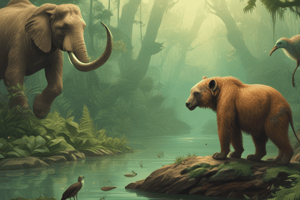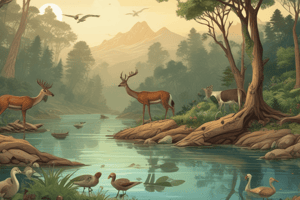Podcast
Questions and Answers
Match the following species with their conservation status:
Match the following species with their conservation status:
Amur tiger = Recovered to over 500 individuals Mountain gorilla = Critically endangered Blue whale = Endangered due to hunting Bees = Facing habitat pressures
Match the following conservation efforts to their outcomes:
Match the following conservation efforts to their outcomes:
Protecting whales = Vital to the carbon cycle Protecting mountain gorillas = Collaboration with local communities Banning hunting of other prey = Rapid recovery of Amur tiger population Habitat protection for bees = Critical for crop pollination
Match the following ecological concepts with their definitions:
Match the following ecological concepts with their definitions:
Ecosystem disruption = Serious consequences for biodiversity Genetic variation = Increases species’ chances of survival Food chain linkage = Interconnectedness of species Conservation efforts = Actions to protect endangered species
Match the following actions with their contributions to species survival:
Match the following actions with their contributions to species survival:
Match the following species with their primary threats:
Match the following species with their primary threats:
Match the following terms to their related concepts:
Match the following terms to their related concepts:
Match the following regions with the species they are home to:
Match the following regions with the species they are home to:
Match the following actions with their ecological impact:
Match the following actions with their ecological impact:
Match the following animal species with their conservation status or historical context:
Match the following animal species with their conservation status or historical context:
Match the following factors to their effects on species extinction:
Match the following factors to their effects on species extinction:
Match the following estimates with their significance in extinction rates:
Match the following estimates with their significance in extinction rates:
Match the following terms related to biodiversity loss:
Match the following terms related to biodiversity loss:
Match the following descriptions with their corresponding animals:
Match the following descriptions with their corresponding animals:
Match the following conservation concepts with their definitions:
Match the following conservation concepts with their definitions:
Match the following years with their significance in animal conservation:
Match the following years with their significance in animal conservation:
Match the following animals with their corresponding challenges to survival:
Match the following animals with their corresponding challenges to survival:
Flashcards are hidden until you start studying
Study Notes
Animal Extinction
- There are an estimated nine million species of animals, and we are still discovering new species.
- It is estimated that between 0.01% and 0.1% of all species could become extinct every year, with this rate leading to between 900 and 9,000 extinctions annually.
- Some animals that were near extinction have been brought back from the brink of extinction.
Factors Contributing to Extinction
- Hunting and habitat destruction are major contributors to animal extinction and near-extinction.
- The gray whale, once hunted to near extinction, now has a protected status and its population has recovered to over 23,000.
Impact of Small Populations
- Small populations experience a limited gene pool, which can lead to weakness and inability to survive.
- The Arabian gazelle once faced decline but has recovered due to protective measures aimed at increasing genetic variation.
Importance of Ecosystem Protection
- Protecting the wider food chain can aid in increasing the population of endangered species.
- The Amur tiger has recovered to over 500 individuals thanks to the protection of its prey animals, such as boars and deer.
Ecosystem Disruption
- Damage to a key part of an ecosystem can affect multiple species.
- The mountain gorilla population has thrived due to conservation efforts that protect their habitat.
- Bee populations are facing challenges due to habitat degradation, which could lead to food shortages as pollination is disrupted.
Consequences of Human Actions
- Protecting whales in the 1960s was initially seen as an endangered species protection measure, but it also benefits the carbon cycle.
- Whale feces, rich in iron, nourish phytoplankton, leading to increased carbon dioxide absorption.
- Extensive whale hunting caused a decrease in phytoplankton populations, further demonstrating unintended consequences of human actions.
Studying That Suits You
Use AI to generate personalized quizzes and flashcards to suit your learning preferences.




